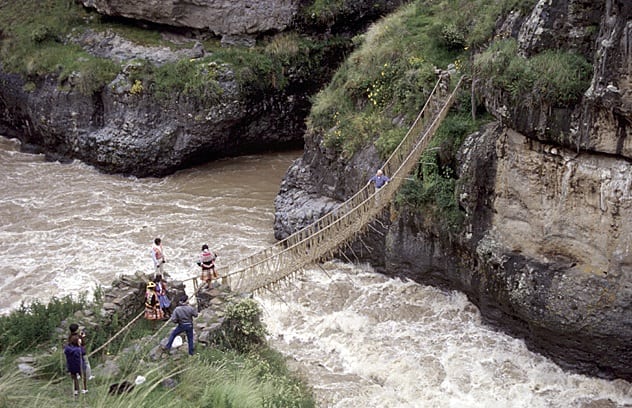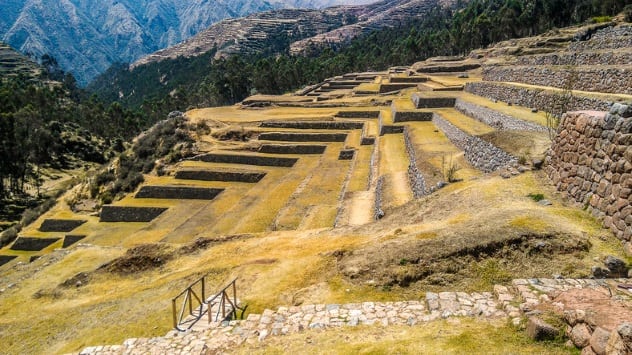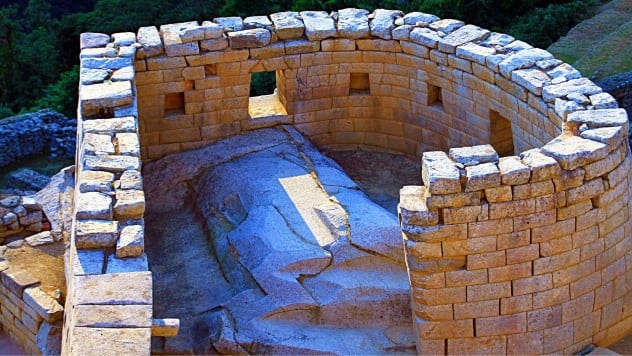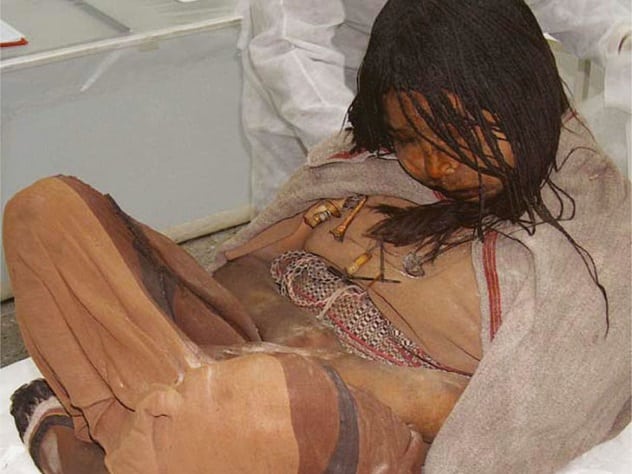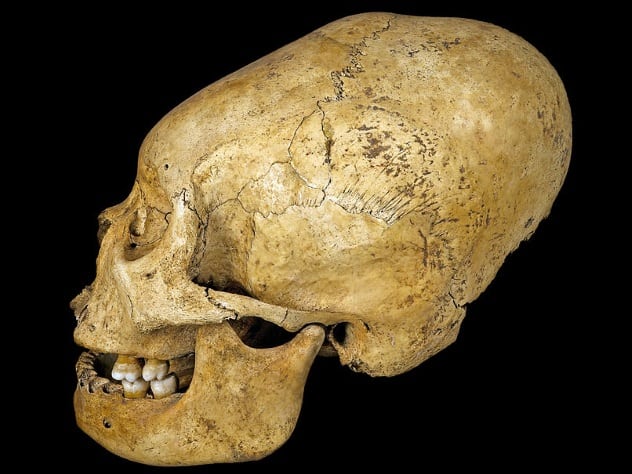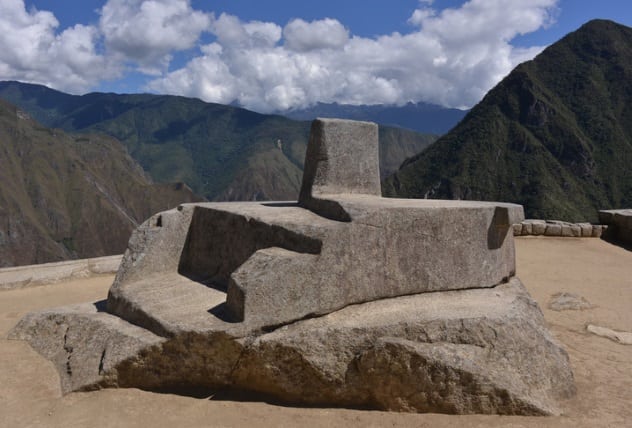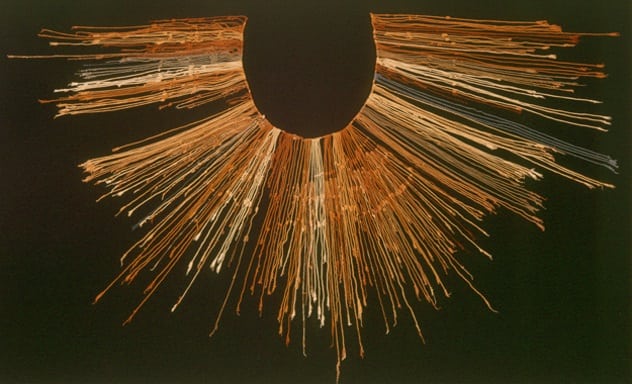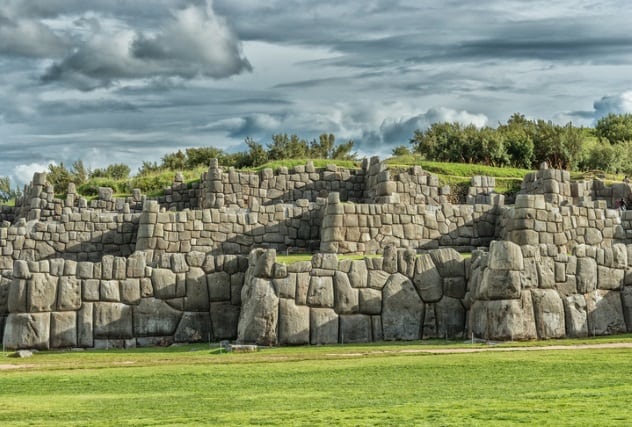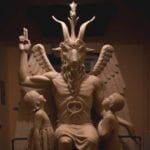Before this, the Incas had already begun to flee the Spanish, abandoning the citadel of Machu Picchu in their hurry to get away from the invaders. The Spanish brought an end to a civilization which included a sophisticated network of roads, a law-abiding society, and a well-developed agricultural system that provided for its citizens.[1] The Incas may have been cut off from the rest of the world by the Andes Mountains, but they left behind a fascinating legacy that is still being studied today.
10 Suspension Bridges
When the Spanish conquistadors invaded Peru, they were dumbfounded at the sight of rope suspension bridges spanning cavernous voids across wide gorges. The Spanish believed themselves to be superior to the Incas, who had not yet invented the wheel, but the Spanish had no idea how to erect such bridges, constructed of twisted fibers made from grass and alpaca wool. The Inca technique for building their rope bridges can still be seen every year at Q’eswachaka (spellings vary), site of the last Inca suspension bridge, where the local inhabitants rebuild their bridge in three days using traditional techniques.[2] Still, it could be worse. The Inca Bridge, the stone path that leads to Machu Picchu, is perilous, only a few feet wide with sheer drops of 76 meters (250 ft) and more. If that wasn’t bad enough, the path has a removable wooden section, used as a drawbridge to stymie invaders. Attacking hordes who had to gingerly make their way along the path would find the wooden planks removed and plunge to their deaths. Though this path is no longer open to the public because of its dangerous nature, tourists have died on the Inca Trail, often by walking off the side of a cliff while taking a selfie.
9 Fantastic Irrigation Systems
The steep Andean mountains are not an ideal environment for farming, but the Incas managed to develop a system of terraces and irrigation that allowed them to plant crops. They cut wide platforms in a step pattern into the sides of the mountains to provide a flat area for growing crops. It is estimated that at the height of the Inca civilization, they had cultivated around one million hectares of land.[3] Stone retaining walls sheltered the terraces from frosts, and the Incas laid beds of dirt, gravel, and sand to help irrigate the soil. They also developed a sophisticated drainage system to channel the water from the mountains in the wet season. Their irrigation systems were so good that their crops could withstand months of drought without damage. Traces of the drainage system can still be found today.
8 They Really Liked Potatoes
And speaking of crops, the Incas were really keen on potatoes. It has been estimated that they cultivated over 3,000 separate varieties of potatoes.[4] That is a lot of spuds. Potatoes had grown wild all over the south of Peru and Bolivia for thousands of years before the Incas began to cultivate their crops. The invading Spanish armies discovered them while looking for El Dorado, never realizing that this humble brown tuber would prove to be worth much more than gold. The Spanish introduced the potato to Europe and, from there, to rest of the world. It was regarded, at first, with extreme suspicion and was used mostly as animal fodder until the upper classes took it up and began to eat it as a novelty. Marie Antoinette is even said to have worn a potato blossom in her hair. Anthropologists believe that the Incas developed a sophisticated seven-year rotation of potato crops, which allowed them to experiment with different varieties. Perhaps someone should have told them about carrots.
7 They Really Were Sun Worshippers
The Incas believed that the Sun god, Inti, was an ancestor of the Inca tribes. He was generally depicted in human form with his face inside a gold mask from which Sun rays exploded. Several Sun temples still exist, including one at Sacsayhuaman and the famous Temple of the Sun at Machu Picchu. In the latter, at the Winter Solstice in late June, the Sun will stream through the window of the temple, casting a perfect rectangle of light around the altar and a needle-sharp shadow which points directly at . . . well, we don’t know what. The summer solstice in December catches the light through the opposite window and does the same thing. The rectangle-shaped rock in the middle of the floor has been described as an altar but is probably too low to have been used as such. However, the groove that has been carved into it casts the shadow only when the Sun is perfectly aligned through the windows. There is still ongoing speculation as to the purpose of this, but it has been suggested that it may have been used to judge the best time for planting crops.[5]
6 It’s Written In The Stars
The Incas were great stargazers. It is believed that the Inca city of Cusco was laid out in a radial pattern, mimicking both the rays of the Sun and some of the constellations. They used their careful measuring of the movements of the stars to determine when to plant and harvest their crops.[6] At Machu Picchu, you will find two mirror pools, which, it is believed, were used to watch the constellations reflected in the water. The Incas were able to recognize the planet Venus and believed that it was a servant of the Sun, sometimes going ahead of it, and sometimes behind, but always remaining close to its master. The Incas built a number of observatories, including Coricancha, at Cusco, which was completely covered with gold. This was destroyed by the pillaging armies of the Spanish invaders. The temple was torn down, and a cathedral was erected in its place, reusing much of the original materials. Only the foundations of the original temple remained. It is a testament to Inca architecture that when an earthquake destroyed the church, the Inca foundations remained unshaken.
5 They Only Occasionally Sacrificed Children
Much has been made of the Inca practice of sacrificing children, and there is some evidence for this. But it seems that this was only ever used as a last resort. Usually, the Incas sacrificed a llama to their gods, typically a black one, which was considered to be rarer and thus more precious. Any llama, at that time, would have been a valuable commodity. They provided wool, meat, and manure for farming and were well-suited to the high altitude and the steep countryside and were often used as pack animals. Llamas were often used as sacrifices to order to ensure a good harvest. A Spanish chronicler described the sacrifice of a black llama during the Festival of the Sun: The Incas took the llama and placed it upon an altar with with its head facing east. While it was still alive, its left side was cut open. They reached into the llama and pulled out its heart, lungs, and entrails, all in one mass. It was believed to be especially lucky if the lungs came out still quivering. However, in difficult times and in periods of famine, the Incas did use capacocha, or the sacrifice of a human, usually a child. Pubescent girls were especially favored. The Inca Empire was situated in the middle of the Pacific Ring of Fire—where the Nazca and South American tectonic plates crash together, causing earthquakes and volcanic eruptions. Additionally, the region suffered El Nino conditions every seven years, which resulted in terrible floods that ruined their crops. The harvests were crucial to the survival of the Incas, so when the future looked particularly bleak, the astronomers and priests ordered the highest sacrifices—their children.[7] Compared to the fate of the llama, however, the sacrifice of the children was quite civilized. To be a human sacrifice was considered a great honor. Only the most beautiful children were chosen from all over the empire. Feasts and festivals were held in their honor. The children would walk to the place of their sacrifice, often hundreds of kilometers, and would be feted all along the way. When the time finally came, they would be drugged with coca leaves and alcohol and then strangled, drained of their blood, or buried alive. The children were often sacrificed in groups, and their bodies would then be buried together with elaborate objects of gold, silver, and ceramics. During excavations in 2004, the remains of seven children were unearthed in Choquepukio, near Cusco. Found with them was an elaborate collection of artificts similar to those from other recent archaeological finds that are believed to be capacocha sacrifices.
4 They Gave The Phrase ‘Big Head’ A Whole New Meaning
The Incas and their ancestors had a fancy for large heads. The elite classes used to bind the heads of their infant children in order to alter their natural growth. Akin to the Chinese practice of foot-binding among the ruling classes, the Peruvian aristocracy took to binding their children’s heads by wrapping two pieces of wood against them with tight bandages until the skull bulged into a teardrop shape, a process now known as artificial cranial deformation.[8] Originating long before the Inca Empire was formed, the Collagua people in Southeastern Peru were binding the heads of well-born babies in order to set them apart from the rest of society. The practice seems to have been adopted by the Incas in order to promote the assimilation of the two communities. However, it soon died out. Images of later Inca kings, such as the great Pachacuti Inca Yupanqui, who built the citadel of Machu Picchu, do not show any cranial abnormalities at all. The elaborate procedure usually began soon after birth and continued for several months, sometimes as long as two years. The side effects of the procedure were surprisingly small. A number of studies have shown that head-binding has negligible effects on the skull itself and that the inevitable alteration of brain shape has no unfortunate side effects. As long as the overall volume of the brain is unchanged, it does not seem to cause any damage.
3 Telling Time Inca-Style
Intihuatanas, aka “hitching posts of the Sun,” are Inca solar clocks. Two still exist, one of which is (of course) at Machu Picchu. Not just a sundial, the four-cornered stone sits at the top of the citadel, and its shadow was used to measure time. The rock itself was a kind of altar for offering up prayers for a successful harvest. The rock was believed to give power to those that touched it—possibly because its position allowed it to absorb the heat of the Sun. The rock was damaged in 2000 when a crane fell on it during the shooting of a beer commercial, and one corner of the rock was shattered into a dozen pieces. Repair efforts were anticipated to be difficult, due to temperature changes that cause the stone to expand and contract, potentially preventing any repairs from lasting very long.[9] Filming is no longer permitted among the ruins.
2 They Couldn’t Write, But They Were Great At Counting
The Inca civilization had no written language, which has made the job of historians and anthropologists quite tricky. Of all the Bronze Age civilizations, the Incas were the only ones not to have any kind writing system. The closest thing that anthropologists have been able to find is a complex system of knots, known as khipus or quipus, that was used largely for counting and keeping a record of financial transactions. Spanish accounts from colonial times claim that Inca khipus also encoded history, biographies, and letters, but researchers have yet to discover any non-numerical meaning in the cords and knots. It is believed that the knots were used to inventory stores of corn, beans, and other provisions. The distance between knots may have conveyed the amount of goods being counted—the greater the distance, the more wheat or potatoes they had in their storehouses.[10]
1 Inca Stonemasonry—How Did They Do That?
The Incas’ most spectacular legacy is their unique way of building that requires no mortar or cement. At Sacsayhuaman (which is spelled many different ways), we can still see the remains of walls built with rocks, some of which weigh more than 100 tons. Huge blocks were quarried locally and shaped using bronze tools, and then they were moved using ropes, logs, and poles. Some of the stones at Sacsayhuaman still have indentations where workers inserted the poles to grip the stone. The rocks were roughly hewed in the quarries and then worked on again at their final destination. The fine cutting and setting of the blocks on-site was so precise that mortar was not necessary. Finally, the blocks were polished smooth with grinding stones and sand. The stones fit together so precisely that mortar was unnecessary, and the Incas developed a building system that included a locking stone, or keystone, with many angles that each other stone fit into. There is a 13-cornered stone at Sacsayhuaman, while Machu Picchu boasts a 32-cornered stone of immense proportions. It is believed that this system of construction allowed the Inca buildings to survive the earthquakes which are prevalent in that area, as the locking system of stones would allow them to move but settle back into their place as the tremor subsided. The Inca building system was a lost art for many years, but archaeologists and historians now believe that the process was completed by first making a mold of the required shape in clay and then tracing that onto the stone to be cut, before painstakingly chipping away at the stone until it fit perfectly.[11] Ward Hazell is a writer who travels and an occasional travel writer.
